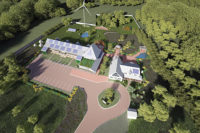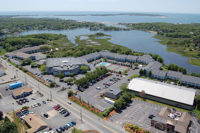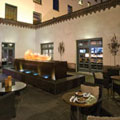
Back in 2005 Hotel Andaluz was in trouble.
The historic Albuquerque, N.M., hotel, formerly known as La Posada de Albuquerque, sat in bankruptcy, a stark contrast from when hotel mogul Conrad Hilton (who built the original structure - the fourth hotel he ever built) and Zsa Zsa Gabor spent the night there before their wedding. The hotel is also known for being the source of key evidence (an Albuquerque Hilton registration card) in the espionage case of Julius and Ethel Rosenberg, who were later convicted and executed for their crimes against the United States.
But in modern times, the hotel had deteriorated into a shell of its former self. Guest rooms had not been updated in two decades. The plumbing system dated back to 1939 (and included 3 gpf toliets), and the last major upgrades to the HVAC and mechanical systems came in 1952.
Enter Goodman Realty, a full-service, national real estate firm that is active in the New Mexico commercial market. The firm bought the hotel out of bankruptcy and launched a $30 million reconstruction project centered on sustainability. Five years later, one of the city’s most recognizable landmarks (it was once the tallest structure in the state and is listed in the National Register of Historic Places) is again flourishing and is now realizing significant energy and water savings on its way to achieving U.S. Green Building Council LEED Gold status.
Hotel Andaluz, however, isn’t the only hotel in the country making green headlines. The Fairfield Inn and Suites by Marriott, located in the Inner Harbor section of Baltimore is a LEED Gold-certified hotel and is the city’s first green hotel. The year-old property is loaded with green initiatives ranging from low-flow bathroom fixtures to the remnants of an old brewery used for the hotel’s rainwater harvesting system.
Both properties have used the sustainability platform to successfully reduce energy and water consumption, while still providing first-class lodging to its guests.
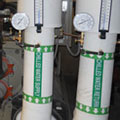
Injecting Green Into A Classic
When Goodman Realty took over the Albuquerque hotel, to say the least, it needed some work.“You can imagine after 20-plus years if you go into a hotel room, the bed and furniture, they’re going to be pretty old,” says Goodman Realty Director of SustainabilityDarin Sand, LEED AP. “One of the major complaints with the heating and air conditioning was it was either too hot or too cold. The air conditioner would leak on the carpet and get wet and would smell at times. It was not a luxury hotel.”
But beyond bringing the hotel back to its once luxurious status, Goodman Realty OwnerGary Goodmanwanted a property that would be sustainable.
“Gary is very passionate about sustainability,” Sand explains. “He wanted to make it a luxury hotel, but wanted to make it as sustainable as possible. He wanted to keep it historic too. The hotel is such an important part of the city. You could call it a historic green renovation.”
A major component of the hotel’s green initiative is water conservation. All 107 guest rooms feature Caroma Caravelle dual-flush, high-efficiency toilets (1.6/0.8 gpf) and Oxygenics Skin Care Series self-pressurizing shower fixtures, while 1.5 gpm aerators are used in the guest bathrooms and public restrooms. Zurn Small Pint 1/8 gpf ultra-low consumption urinals are in the public restrooms.
Two Trane water chillers and a Baltimore Aircoil Co. cooling tower add to the sustainability blueprint. A total of 11 Bell & Gossett water pumps are installed in the facility.
Thus far, the hotel has produced significant water savings. Back in May 2004, the hotel, still known as La Posada, used 1.2 million gallons of water that month.
Since it opened last October, Hotel Andaluz is now consuming an average of 770,000 gallons of water less per month than its predecessor. In May 2010, the hotel used only 300,000 gallons of water. When comparing both hotels’ water usage for an eight-month period, Hotel Andaluz used 78% less water than La Posada during the measured timeframe.
“The interesting point is the chiller runs year-round with a four-pipe system,” Sand says. “With the two-pipe system, the cooling tower would shut down in the winter. We’re still conserving water even though the cooling part is still running. The new chillers and the low-flow toilets and showerheads have all combined to lower water usage.”
The hotel is also in the process of installing a rainwater capture system (three 2,500-gallon cisterns) to serve as irrigation for exterior and interior landscaping.
“That’s not even included in that 770,000 gallon (average savings per month) figure,” Sands notes. “The water savings we are realizing is impressive.”
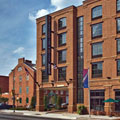
Energy Reduction
On top of its water-saving initiatives, the hotel also utilizes a 73-panel solar thermal system (panels by Solar Skies Mfg.; solar circulation pumps by Grundfos) that provides 60% of the domestic hot water for the hotel. A 4,000-gallon storage tank sits on the roof of the hotel.“We get a lot of sunny days here,” Goodman Realty Operations ManagerPete VanOrrensays. “If the solar-supplied water gets to 120° or higher, the domestic hot water boilers (by Laars Pennant) don’t come on. The thermal storage tank will continue to deliver water to the hotel for two or three days depending on the demand. It works quite well.”
Other energy-efficient technologies include the use of state-of-the-art building energy control systems (which through heat sensors and motion detectors lower air temperatures when guests are not in rooms), LED and compact fluorescent interior lighting and the use of bamboo furnishings.
The hotel is in the process of applying for LEED Gold status. Sand says one of the last remaining LEED Gold components, along with the rainwater system and resurfacing of the parking lot with a high-reluctant coating, is the installation of a building dashboard.
“That shows our guests in real time our electrical usage compared to a traditional building,” he explains. “You’ll also be able to see with our gas and our solar system how much hot water we are generating.”
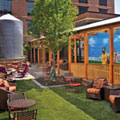
Green Everywhere
When you walk into the Fairfield Inn & Suites by Marriott in Baltimore, it’s hard to not notice the 154-room property’s commitment to green technologies.There’s the green hotel car parked in the front of the facility and the various green motifs in the lobby and in the guest rooms. The hotel’s Web site (www.greenfairfieldinn.com) drives home the point, as does the LEED Gold plaque in the front foyer of the building.
“We went to our design team to see what it would take to get LEED Gold certification,” says Summitt Associates FounderGene Singleton, the owner of the hotel. “We decided to put our heads down and make it happen.”
Like Hotel Andaluz, the Fairfield Inn & Suites is filled with water-saving bathroom fixtures. Dual-flush toilets by Kohler are installed in all guest rooms and public restrooms. Low-flow showerheads (2.0 gpm by Speakman) and lav faucets (American Standard) also reduce water consumption in guest rooms as do waterless urinals (Kohler) in the hotel public restrooms.
“We’re saving at least 40 to 50% in water usage compared to conventional hotel fixtures,” notesAbdi Hejazi, a principal at SAH Design Group in Annandale, Va., and the chief MEP engineer on the hotel project.
Between the green technologies employed with the plumbing, HVAC and building insulation, the Fairfield Inn & Suites, which provides mountain bikes for guests who stay in its special Eco Suites, is 33% more efficient than a structure built to standard codes.
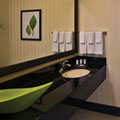
Brewery Roots
A unique aspect of the hotel’s sustainability commitment taps into the property’s rich history. The hotel site was once home to Clagett’s Brewery and in recent years housed the Baltimore Brewing Co. The site also once housed a malt room in which seamstress Mary Pickersgrill sat and stitched the flag that inspired Francis Scott Key’s homage to “the star-spangled banner.”Part of the brewery history remains to this day. The hotel has incorporated a 30-foot tall grain silo - once used as a beer storage tank - into it’s courtyard. The silo now captures rainwater runoff that is recycled and used for landscaping irrigation.
“The storm water is piped from the roof directly to that tank,” Hejazi explains. “It’s a huge tank that stores approximately 6,000 gallons. We’re reducing the load on the city lines. When we’re not able to use all of the water, we let it go into the city storm system.”
Hejazi notes keeping the aesthetic look of the hotel was important when dealing with the silo.
“It is a hotel, after all,” he says. “The design was a little bit challenging because it is a historic thing. Nobody realizes what the pipes are there for. They think they’re part of the old brewery.”
The hotel features a green roof, which helps reduce the volume of storm water flowing into streams and drainage channels.
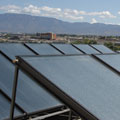
Keep The Hot Water Flowing
As Hejazi points out, the biggest demand in a hotel setting comes in the form of hot water. That’s why four A.O. Smith condensing pipe water heaters were installed in this project.“For any hotel, dometic hot water is a real energy consumer,” he states. “The thermal efficiency of the intstalled water heaters is almost 96% vs. a conventional system that has 80% efficiency. The exhaust gases from these heaters are just live water vapor. The level of CO discharge to the atmosphere is much less than a conventional system. Due to high efficiency and fast recovery, the output of these units is such that the hotel never runs out of hot water.”
The hotel’s HVAC system packs a powerful and sustainable punch. The HVAC units (Carrier Infinity) feature a two-stage compressor and the highest energy efficiency ratio on the market (EER of 16 to 19). PTAC units (Amana) have an EER of 12.7 (12.7 Btuh of cooling can be provided with consumption of 1 watt of compressor power). And just like Hotel Andaluz, guest room thermostats (by INNCOM) feature motion and door switch detectors that moderate temperature based on room occupancy.
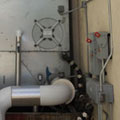
The Big Picture
Singleton, who has been building hotels for 30 years and recently saw his Marriott TownePlace Suites property at BWI Airport also receive a LEED Gold certification, is hopeful guests will remember their green experience after they leave the hotel.“A hotel is a lot different than an office building,” he says. “The same people go in and out of an office building. We’re seeing 150 different people a day and have the opportunity to interact with as many as 60,000 different people every year. Hopefully, we can raise their (green) awareness and maybe they’ll go back and change their lifestyle.”
Sand also feels Hotel Andaluz will leave a distinct impression with its guests.
“The design and the modern conveniences have taken things up a number of notches,” Sand says. “We’re a world-class hotel with people coming in from all over the world. This hotel could be anywhere from New York to London. We now have a product that this state has never had before.”

